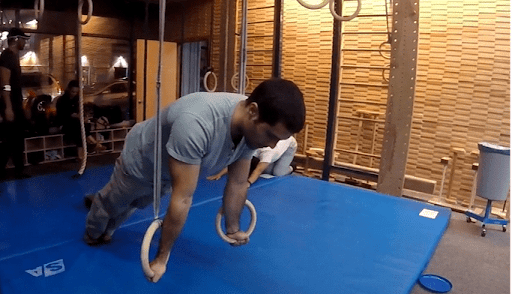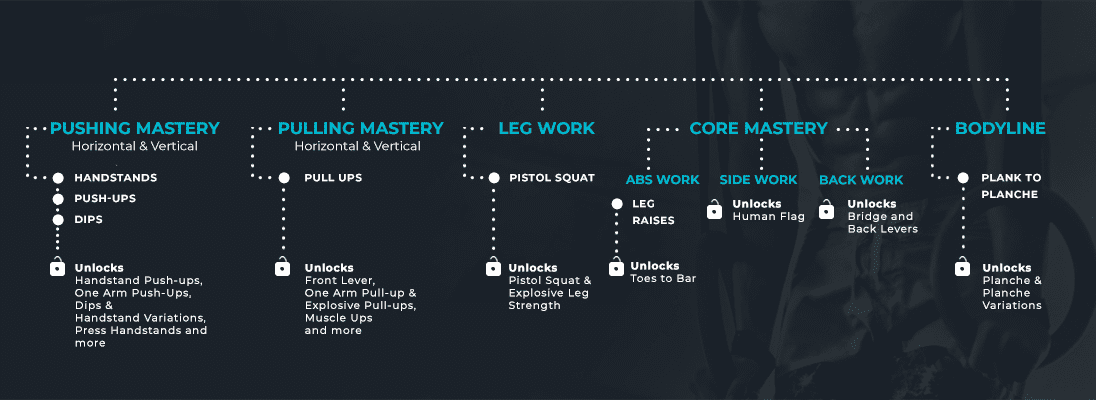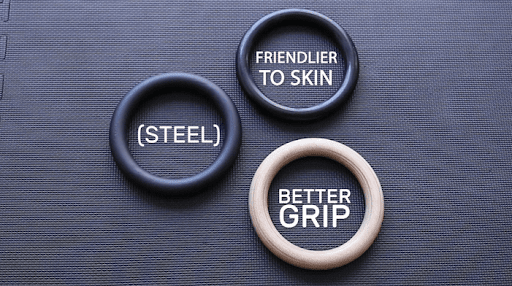Push-ups are one of the most popular exercises in gyms across the world. They can be done with just your body weight, or they can be assisted by using a bench, chair, or aerobic step.
Push-ups are a great exercise for chest and tricep development.
The problem, however, is that people don’t know how to make them progressively more challenging over time.
👊The solution is to use gymnastics rings, one of the best calisthenics equipment, that can increase the difficulty of any bodyweight fundamental. Because of the instability factor added, any push-up will guarantee to be more challenging to stimulate your muscles for growth.
A smart training program will get you relatively proficient at basic push-ups on the floor quite quickly, and once someone is capable of performing 30+ reps in a row, they tend to start favoring other movements like the bench press as their primary upper body horizontal pushing exercise for lower rep strength work.💪
Then again, some trainees set their sights on hitting a round number like 50 or 100 push-ups as a short-term goal but even then, the focus is on improving muscular endurance via higher reps as opposed to working and making gains in the traditional strength and hypertrophy rep ranges (5-12 reps or so per set).
Thus, push-ups are often labeled a “beginner exercise” and drastically overlooked as a strength-building exercise by many gym-goers.
So how does one go about making push-ups challenging for even the more advanced trainee?
🎯Advanced pushups on gymnastics rings
Gymnastic rings are one of the cheapest and most versatile training equipment money can buy, and an excellent addition in your workouts for enhancing upper body strength and muscles once regular push-ups on the floor become a walk in the park.
🔎Basic requirement
You can’t just jump into gymnastics ring training just yet. The demands of instability are present in multiple planes. You don’t just need to resist movement laterally, or horizontally. The rings are free to move anywhere.
A strong chest, shoulder, and core engagement are required to maintain a solid hold even just in the push-up position.
🔥Fundamentals
This is why mastery of the calisthenics fundamentals IS A MUST.
Training the basics will ensure that you have a proper foundation for training with gymnastics rings properly and safely.
There’s no point in training your ring push-ups if you don’t have mastered the traditional push-ups on the floor.
Other than that, a fundamental workout teaches proper technique, body alignment, and overall strength for both push and pull movements and your core.
Any weakness on any of the aspects will reflect in this advanced calisthenics workout. Master your fundamentals so you can enjoy the benefits of the gymnastic rings.
For more help with your fundamentals, check out The Movement Athlete.
On the site, you can develop the necessary foundation for the ring push-ups.
💯Support hold

Ring push-up support hold performed by StrengthEdu
Once you have covered the basics, the next step is to learn the first position on the gymnastic rings: the support hold.
This is a straight arm exercise that strengthens your joints, particularly the elbows and shoulders which stabilize you in the top position.
The support hold is crucial to achieving maximum chest, shoulders, tricep, and core engagement when performing the ring push-ups. It also teaches the proper form for more advanced variations.
To perform, simply go into a push-up position then slowly TURN YOUR HANDS OUTWARDS until your palms are facing forward. The external rotation will add even more instability which you need to resist by stabilizing your shoulder, chest, and tricep muscles even further.
You can adjust the intensity of the exercise by increasing the height of the straps and placing your body more vertically. Over time, aim to lower down until your body is parallel to the ground. As you get stronger, you can even go into the vertical support hold for dips.
Usually, people need to condition their elbows first before even attempting the ring push-ups. Most people are not used to straight arm mechanics.
Here’s a video that could help with your elbows.
Train smartly and don’t overdo your elbow conditioning when first starting out since it can lead to tendonitis or another injury. Joints tend to recover slower compared to our muscles. So train smart to save yourself from any trouble.
💪More challenging exercises
Due to the added instability factor, the rings require significantly more stabilizer strength than when hands are kept firmly on the ground. Consequently, you’ll feel push-ups on rings much more in your abs and experience some amazing chest, shoulder, and tricep pumps.
Not only that, the benefits of gymnastic rings can be used for other elements of your workout such as the focus on your legs, core, and pulling exercises. Rings also help “isolate” muscle groups for better muscle development goals.
🤸Adjusting the difficulty
Gymnastic rings are a fantastic way to increase the difficulty of any traditional exercise. Just lower the rings and expect a huge increase in difficulty.
🤔What type of gymnastic rings to look for?
Good thing there are not a lot of choices to choose from. The main difference in rings is the material.
Photo from Bodyweight Muscle
✅Wooden rings
This is the standard. You can’t go wrong with wooden rings. It’s affordable, relatively durable, light if you decide to carry it around, and does the job perfectly.
The grips feel a lot better even if you are sweating so you don’t always need to chalk up. And if you’re into aesthetics, wooden rings look so good.
✅Plastic rings
Rings made from plastic are the cheapest, but also the most durable. They are also the lightest. The downside is the grip. You will tend to slip off the rings even with maximal grip strength. But you can always use chalk if you decide to use plastic rings.
✅Steel
This is the heaviest among the three. It is also the most expensive but the rough steel surface can provide additional grip if you’re hands aren’t too sweaty. Just be careful letting them go as it may swing right into your face.
✅Ring size
There are two main ring sizes available on the market—the smaller 1.1-inch size and the larger 1.25-inch size. You can think that the bigger grip allows better forearm muscle and grip development but it still boils down to preference.
✅Buckle
Safety first! Make sure the quality of the buckle is sturdy enough to hold your full body weight and more!
For a more comprehensive guide on choosing your first gymnastic rings, check out this amazing article by Bodyweight Muscle.
✅Straps
Any good strap would do. Just make sure it can hold you up. You can also check outnumbered straps for convenience when you adjust the right height.
✅Anchor point
The safety of the rings also heavily relies on your anchor point. Make sure it’s sturdy enough and can hold more than your body weight.
✨A few key pointers for all of the following ring push-up variations:
- ✊ Squeeze your glutes and brace the abs
- ✊ Maintain full-body tension
- ✊ Don’t allow sagging of the hips and arching of the lower back
- ✊ Own the eccentric part of the movement by lowering it under control
- ✊ Full range of motion: meaning turn your hands and elbows outwards at the starting position
- ✊ Shoulders depressed at all times
- ✊ Scapula retracted at the bottom
Read more here: 10 Common Push-up Mistakes You Need to AVOID!
🔥Variation #1 – Weighted Ring Push-Ups
This is your standard ring push-up exercise with added resistance. Wear a weight vest or add weight plates to your back, perfect for developing muscles and primary exercise for general absolute pushing strength.
You’ll notice that as long as you have a capable spotter helping out once the poundages start climbing into the heavy territory, you’ll be able to externally load ring push-ups for quite some time.
Add weights slowly to avoid injury, and only add weights when you have mastered the regular ring push-ups.
For the form, keep your elbows and arms tucked close to your body to engage the muscles safely. Keep tension throughout the movement and press up using your triceps and chest.
🔥Variation #2 – Wide Ring Push-Ups
As you’re descending into the wide push-up, turn your palms so that they’re facing your feet and spread the rings out to your sides. Make sure that you’re keeping your elbow movement in the scapular plane, meaning arms aren’t moving past your shoulders. This is great for adding more volume for chest muscle growth.
🔥Variation #3 – Ring Flye
While technically not a push-up, the ring flye nevertheless provides for an excellent variation as you inch towards more and more demanding ring push-up progressions.
Ring flyes are perfect for your chest workout as it can “isolate” your chest muscles while lessening the assistance from your triceps. This allows more volume which stimulates muscle recruitment.
You want a bigger chest? Do ring flyes.
As with the form, keep pushing the rings out and away from you but this time keep the palms facing each other. The straighter the arms, the more difficult this movement becomes. The more you lower the rings, the harder the exercise also is.
Keep the movement within the scapular plane as mentioned in the wide ring push-ups.
🔥Variation #4 – Ring Archer Push-Up
Here you’ll straighten one arm as you’re descending while keeping the other arm firmly tucked in close by your side, resembling an archer aiming and ready to fire an arrow at his target in the bottom position.
As you’re coming back up, think of simultaneously pushing with the arm closer to you and pulling with the straight arm to return back to the starting position.
Notice that as I’m going down, I shift my body away from the arm I’m straightening, which is an easier variation of the ring archer push-up. You can make this movement even harder by keeping your body completely still from the chest down throughout the exercise.
Keep your feet slightly apart to add stability.
🔥Variation #5 – Ring Modified Planche Push-Up
Begin in the push-up position but lean forward to add tension on your frontal shoulder.
As you’re lowering into the push-up, start turning your hands so that your palms end up facing your face slightly before hitting rock bottom, then maintain hand position until you’ve gone all the way down.
Reverse the motion when coming back up into the starting position.
This exercise is great for increasing your press movements especially when you transition into the ground.
🔥Variation #6 – RTO Push-Up
These are A LOT HARDER than they look.
It takes a great deal of strength to prevent the rings from turning back in this position and you’ll be shaking out of control while trying to maintain control of them in the middle of a rep when first giving these bad boys a go.
As you can see in the video, my right arm struggles slightly to keep the right ring from turning back in (rep #2 looked pretty good though).
Most people will not be able to do RTO push-ups in a smooth manner with their palms fully facing away from them at first. Start with the rings at 45 degrees and work your way forward from there, opening them further out as the weeks pass by and you begin getting the hang of these.
Begin your ring training.
Give these 6 ring push-up variations a try and experience a marked increase in your upper body pushing strength.
Ready to take on the rings and experience a marked increase in upper body pushing strength? Then give these 6 ring push-up variations a try.
But what if these are just too hard?
Then we go back again to the basic movement patterns. Master the fundamentals with PERSONALISED and ADAPTIVE calisthenics workout.
Don’t settle for 📍 cookie-cutter beginner/intermediate/advanced workouts. Not all beginners are the same like not all advanced bodyweight athletes are the same.
☝️Begin your journey with the basics so you can enjoy the benefits of the advanced bodyweight training style that gymnastics rings can only offer.
Personalised training starts with a free assessment to get a “diagnosis” of where you currently are in terms of skill level.
TAKE THE ASSESSMENT NOW! 💪


